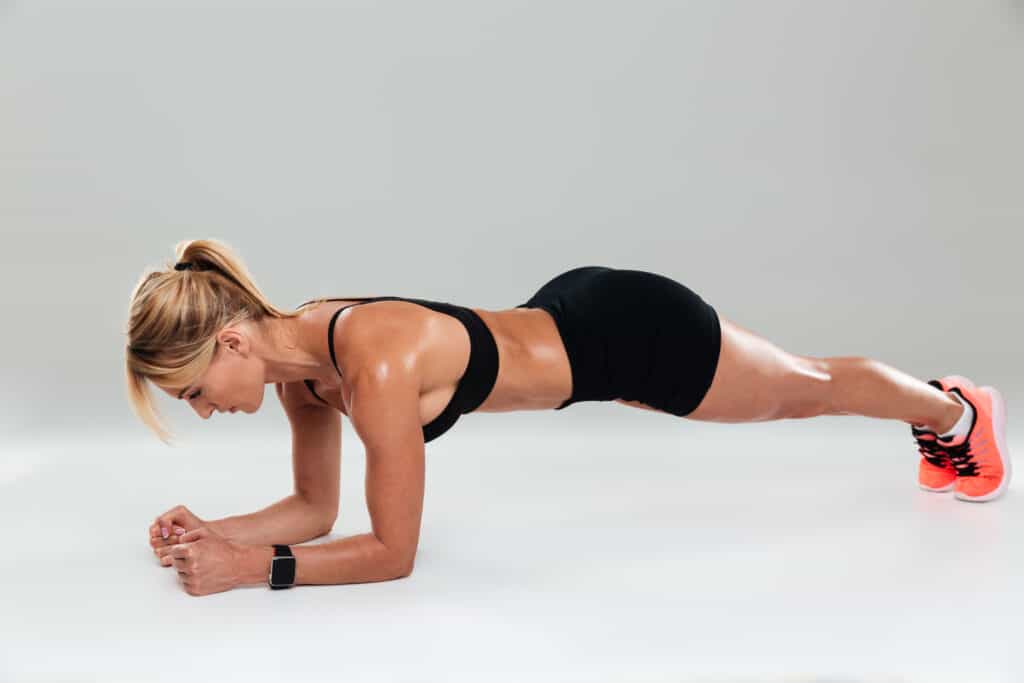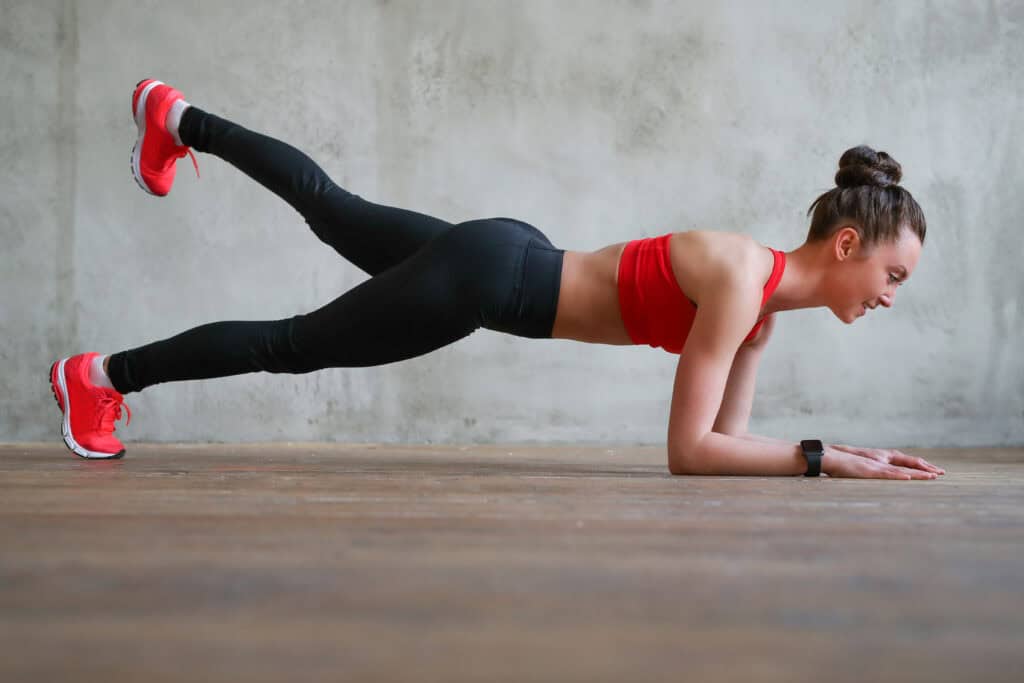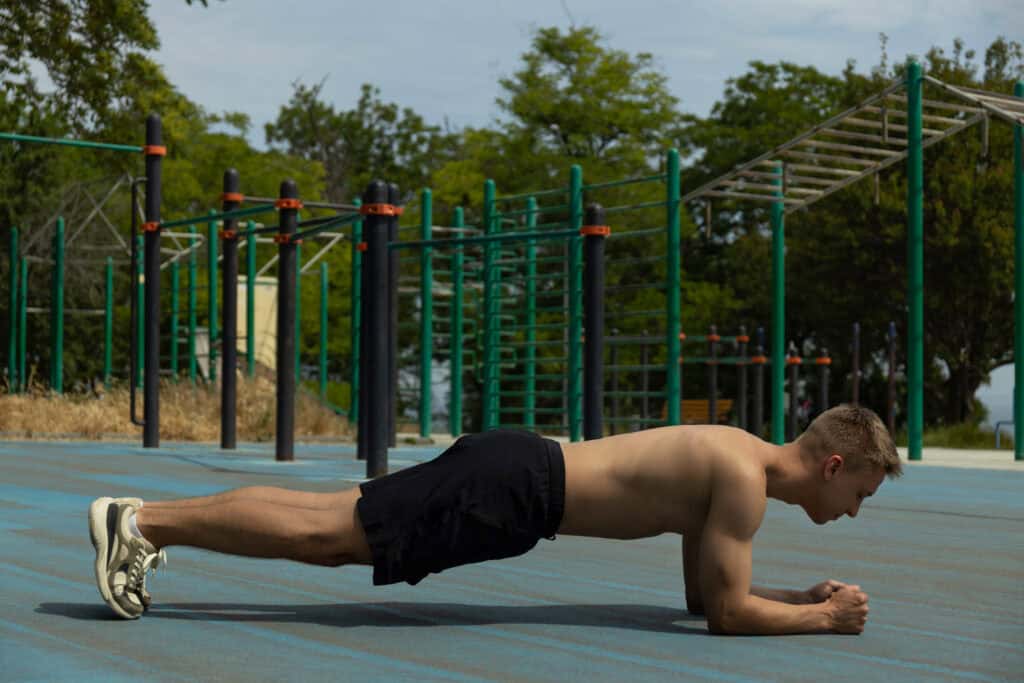The plank is a fundamental core exercise used by beginners, elite athletes and gym-goers alike. Two of the more common variations are the forearm plank and the straight arm plank. Both exercises appear similar but activate muscles differently. Note, the straight arm plank is also referred to as extended arm plank. In this article, we’ll compare the two exercises based on electromyography (EMG) research and explore whether adding hip extension enhances core engagement and overall exercise intensity. Additionally, we’ll include exercise tips for optimal performance.
Understanding the Basics: Forearm Plank vs. Straight Arm Plank
Forearm Plank
The forearm plank, often referred to as the “low plank,” involves resting on your forearms while keeping the rest of your body in a straight line from head to toe. This exercise targets the rectus abdominis, transverse abdominis, and obliques while also engaging the shoulders and glutes for stabilization.
Straight Arm Plank
In the straight arm plank, also known as the “high plank,” the hands are placed directly under the shoulders, and the arms are fully extended. This version mimics the top position of a push-up. While it also targets the core muscles, it shifts more emphasis to the shoulders, chest, and triceps due to the arm position.
EMG Comparison: Which Exercise Activates the Core Muscles Better?
EMG studies help determine the effectiveness of exercises by measuring the electrical activity of muscles during movement. When comparing the forearm plank and the straight arm plank, research indicates subtle but significant differences in muscle activation.
EMG Findings for the Forearm Plank
The forearm plank tends to produce higher EMG activity in the rectus abdominis and transverse abdominis, which are the primary muscles responsible for stabilizing the core. A study published in the Journal of Strength and Conditioning Research found that the forearm plank results in greater abdominal activation compared to the straight arm plank. This makes the forearm plank more effective for those looking to target their core muscles specifically.
EMG Findings for the Straight Arm Plank
The straight arm plank, on the other hand, generates more muscle activity in the upper body, specifically the pectoralis major, anterior deltoids, and triceps. Because the arms are bearing more weight in this version, the core muscles are still engaged but to a slightly lesser degree. The straight arm plank can be a better option for individuals looking to combine core and upper-body training in one exercise.
Exercise Tips for Optimal Performance
Regardless of which plank variation you choose, proper form is essential to prevent injury and maximize muscle activation.
- Maintain a Neutral Spine: Whether you’re doing a forearm or extended arm plank, keep your body in a straight line from head to heels. Avoid sagging your hips or arching your back.
- Engage the Core: Actively contract your core muscles throughout the exercise. Think about pulling your belly button toward your spine.
- Avoid Flaring the Elbows: In the extended arm plank, keep your elbows close to your sides to minimize strain on the shoulders and ensure maximum core engagement.
- Control Your Breathing: Breathe steadily throughout the plank to ensure proper oxygen flow to the muscles. Holding your breath can reduce performance and endurance.
The Impact of Hip Extension on EMG and Exercise Intensity
Adding hip extension—such as lifting one leg off the ground during the plank—has been shown to increase the difficulty and muscle activation of the exercise. A study in the Journal of Physical Therapy Science explored the impact of lifting the leg during a plank, finding that it significantly increases EMG activity in the glutes, hamstrings, and erector spinae.
How Hip Extension Boosts Muscle Activation
- Increased Core Demand: When one leg is lifted, the body must compensate for the loss of stability. This forces the obliques and transverse abdominis to work harder to maintain balance, which enhances core activation.
- Glute and Lower Back Engagement: Lifting a leg during the plank also activates the gluteus maximus and the erector spinae, two muscle groups critical for posterior chain strength. This combination makes the exercise more dynamic and provides greater overall body benefits.
Is Hip Extension Worth It?
If your goal is to increase core engagement and overall exercise intensity, adding hip extension to either the forearm or extended arm plank is a valuable progression. EMG studies suggest that this variation enhances muscle activity not only in the core but also in the glutes, hamstrings, and lower back, making it a more comprehensive movement.
Which Plank Variation Is Better?
The answer to which plank variation is better depends on your fitness goals.
- For Core-Specific Training: If you’re primarily focused on building core strength and endurance, the forearm plank is the better option according to EMG studies. Its lower position recruits the rectus abdominis and transverse abdominis more effectively.
- For Upper Body and Core Combination: If you’re looking for an exercise that also targets your shoulders, chest, and triceps while still engaging your core, the straight arm plank is the better choice.
Exercise Variations and Progressions
For individuals looking to progress in their plank exercises, incorporating hip extension or dynamic movements like plank shoulder taps or plank jacks can further enhance both core and upper-body activation. These variations not only improve muscle engagement but also increase the cardiovascular intensity of the exercise.
- Plank Shoulder Taps: From an extended arm plank, lift one hand and tap the opposite shoulder while maintaining core stability. This adds a challenge to your balance and coordination.
- Plank Jacks: Start in a forearm or extended arm plank and jump your feet in and out like a jumping jack. This increases the intensity and heart rate while engaging the core.
Conclusion: Plank Variation with Hip Extension for Maximum Benefit
In terms of EMG research, the forearm plank provides superior activation of the core muscles, particularly the rectus abdominis and transverse abdominis. The straight arm plank shifts more emphasis to the upper body, making it a more comprehensive exercise for combining core and upper-body training.
If you’re looking to maximize muscle activation and exercise intensity, adding hip extension to either variation significantly boosts EMG activity in the glutes, hamstrings, and lower back, making the plank a full-body workout. Whether you’re a beginner or an advanced athlete, varying your plank exercises and incorporating progressions will help you achieve greater overall strength and endurance.

References
- Journal of Strength and Conditioning Research, EMG Activation in Core Exercises, 2017.
- Journal of Physical Therapy Science, The Effects of Plank Exercise with Hip Extension, 2019.
- Journal of Sports Science and Medicine, EMG Analysis of Core Stability Exercises, 2016.
- National Strength and Conditioning Association, Guidelines for Core Training, 2020.
By optimizing your plank exercises and incorporating progressive variations, you’ll be able to achieve greater strength, stability, and overall fitness. Make sure to experiment with different forms and intensities to find what works best for your goals!
Comparing Side Plank and Straight Arm Plank with Shoulder Taps
In the first batch of exercises, we compared the forearm plank and straight arm plank, focusing on core engagement and muscle activation based on electromyography (EMG) research. Both exercises provide solid core-strengthening benefits, with the forearm plank better targeting the core and the straight arm plank engaging the upper body more significantly.
Now, we’ll introduce two new variations: the side plank and the straight arm plank with shoulder taps. These exercises offer additional challenges in terms of stability, muscle activation, and overall intensity. We’ll compare them to the original plank exercises to see if they are more effective in terms of EMG activity, intensity, and total body engagement.
Understanding New Exercises: Side Plank and Straight Arm Plank with Shoulder Taps
Side Plank
The side plank is performed by lying on one side and lifting your body off the ground with one forearm or hand while maintaining a straight line from head to feet. This exercise primarily targets the obliques, a key muscle group responsible for lateral stability. The glutes, shoulders, and quadratus lumborum (deep core muscles) are also engaged.
Straight Arm Plank with Shoulder Taps
The straight arm plank with shoulder taps adds a dynamic element to the basic plank. Starting in a straight arm plank position, you alternate lifting one hand off the ground to tap the opposite shoulder while maintaining core stability. This variation introduces an anti-rotational component, forcing your core and stabilizing muscles to work harder to prevent your hips and torso from twisting.
EMG Analysis: How Do These Exercises Compare?
Side Plank
The side plank excels at engaging the obliques and improving lateral core strength, which is often overlooked in traditional plank exercises. According to a study published in the Journal of Orthopedic & Sports Physical Therapy, the side plank generates higher EMG activity in the internal and external obliques compared to both the forearm and straight arm plank.
In addition, the gluteus medius (a key stabilizer of the pelvis) and the quadratus lumborum are more activated in the side plank than in traditional planks. This makes the side plank a superior exercise for lateral stability and posture correction, which can improve overall performance in sports and daily activities that require rotational movements.
Straight Arm Plank with Shoulder Taps
The straight arm plank with shoulder taps adds a new level of intensity by engaging anti-rotational muscles, particularly the obliques, serratus anterior, and rectus abdominis. In comparison to the basic straight arm plank, shoulder taps increase EMG activity in the core, as the body must resist rotation and maintain balance. Research shows that this variation significantly boosts stability demand and challenges the shoulders, chest, and triceps .
According to a study in the Journal of Strength and Conditioning Research, adding dynamic movements (such as shoulder taps) to planks enhances muscle recruitment and increases core activation, particularly in the transverse abdominis and obliques. This makes the exercise more functional, simulating real-life movements where stabilization is critical.
How Do these Exercises Compare to the Forearm Plank and Extended Arm Plank?
Core Activation
- Forearm Plank: Best for targeting the rectus abdominis and transverse abdominis with minimal upper-body involvement.
- Straight Arm Plank: Good for core activation but engages more of the upper body—particularly the chest, shoulders, and triceps—than the forearm plank.
- Side Plank: Superior for targeting the obliques and improving lateral stability. It also engages the glutes and quadratus lumborum more than the forearm and extended arm plank, making it a better exercise for overall core strength and stability.
- Straight Arm Plank with Shoulder Taps: Offers the most dynamic core engagement by adding an anti-rotational challenge. It enhances core activation beyond the traditional extended arm plank due to the stabilization needed during the taps.
Winner in Core Activation: The straight arm plank with shoulder taps provides the most comprehensive core engagement due to the added rotational challenge, followed closely by the side plank for its focus on oblique strength.
Stability and Balance
- Forearm Plank: Offers good stability but lacks the dynamic challenge of the side plank or shoulder taps.
- Straight Arm Plank: Similar stability to the forearm plank but with more upper-body involvement.
- Side Plank: Improves lateral stability and is excellent for training core muscles that prevent side-to-side movement.
- Extended Arm Plank with Shoulder Taps: Adds an anti-rotational challenge, improving balance, coordination, and overall core stability.
Winner in Stability and Balance: The extended arm plank with shoulder taps offers superior benefits due to the anti-rotational component, closely followed by the side plank for lateral stability.
Upper Body Engagement
- Forearm Plank: Minimal upper-body activation.
- Extended Arm Plank: Targets the shoulders, chest, and triceps in addition to the core.
- Side Plank: Activates the shoulders, particularly the deltoids, but less so than the extended arm plank.
- Extended Arm Plank with Shoulder Taps: Provides significant upper-body engagement, particularly in the serratus anterior, deltoids, and triceps, while still emphasizing core stability.
Winner in Upper Body Engagement: The extended arm plank with shoulder taps engages the upper body more effectively due to the alternating shoulder taps, which activate the deltoids, triceps, and serratus anterior.
Impact of Hip Extension on the New Exercises
We previously discussed how adding hip extension to the forearm or extended arm plank can enhance muscle activation, particularly in the glutes and lower back. The same holds true for the side plank and extended arm plank with shoulder taps. Incorporating hip extension into these exercises can further increase the difficulty and muscle engagement.
- Side Plank with Hip Extension: Lifting the top leg while holding the side plank increases gluteus medius activation and further challenges lateral stability. This variation is particularly effective for strengthening the hip abductors.
- Extended Arm Plank with Shoulder Taps and Hip Extension: Adding a leg lift during shoulder taps intensifies the exercise by increasing the demand on the glutes, hamstrings, and lower back, while still challenging the core and upper body.

Conclusion: Are the New Exercises Better?
The side plank and extended arm plank with shoulder taps offer additional benefits over the traditional forearm plank and extended arm plank:
- Core Activation: The extended arm plank with shoulder taps and side plank are superior to the forearm plank and extended arm plank due to their ability to engage more muscles, particularly the obliques and stabilizing muscles.
- Stability and Balance: Both the side plank and shoulder taps introduce dynamic elements that challenge the body’s ability to balance and stabilize, making them more effective for improving overall functional strength.
- Upper Body Engagement: The extended arm plank with shoulder taps provides more upper-body engagement than both the forearm and extended arm planks, making it a better choice for those seeking to combine upper body and core training.
Overall, if your goal is to maximize core strength, stability, and overall muscle engagement, incorporating side planks and extended arm planks with shoulder taps into your routine will provide superior results compared to the traditional plank variations. Adding hip extension can further increase the intensity, providing a full-body workout that challenges multiple muscle groups simultaneously.
References
- Journal of Orthopaedic & Sports Physical Therapy, EMG Analysis of Side Plank for Oblique Activation, 2018.
- Journal of Strength and Conditioning Research, Impact of Dynamic Plank Variations on Core Activation, 2019.
- Journal of Physical Therapy Science, The Effects of Hip Extension on Plank Exercises, 2017.
- Journal of Sports Science and Medicine, EMG Findings on Core Stability Exercises, 2020.
By incorporating these advanced plank variations into your fitness routine, you can build a stronger, more stable core and upper body while improving overall functional strength. A sampling of Jefit’s core programs can be found here.
Stay Strong Together
For those looking to enhance their fitness journey, the award-winning Jefit app is an invaluable tool. Jefit offers personalized workout plans, extensive exercise libraries, and progress tracking features to help you reach your health goals. Whether you’re focusing on your carb intake, aiming to build muscle, or seeking to improve overall fitness, Jefit provides the resources and support needed for success. Join millions of users worldwide who have transformed their lives with Jefit, and take control of your health and fitness today.
- Boost Your Posterior Strength with 3 Effective Jefit Exercises - March 31, 2025
- 8 Underrated Stretches to Improve Your Deadlift Performance - March 28, 2025
- Strength vs. Hypertrophy: Best Way to Train for Your Goals - March 26, 2025
